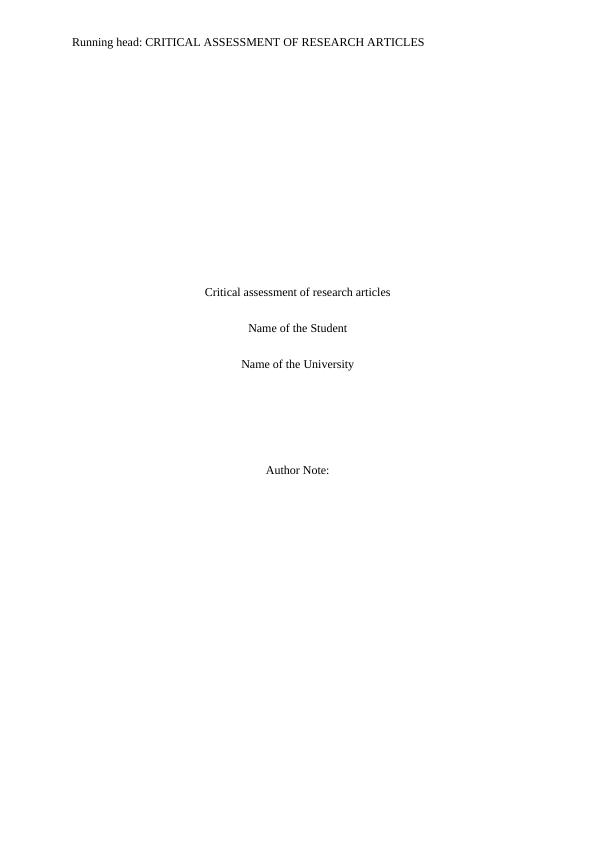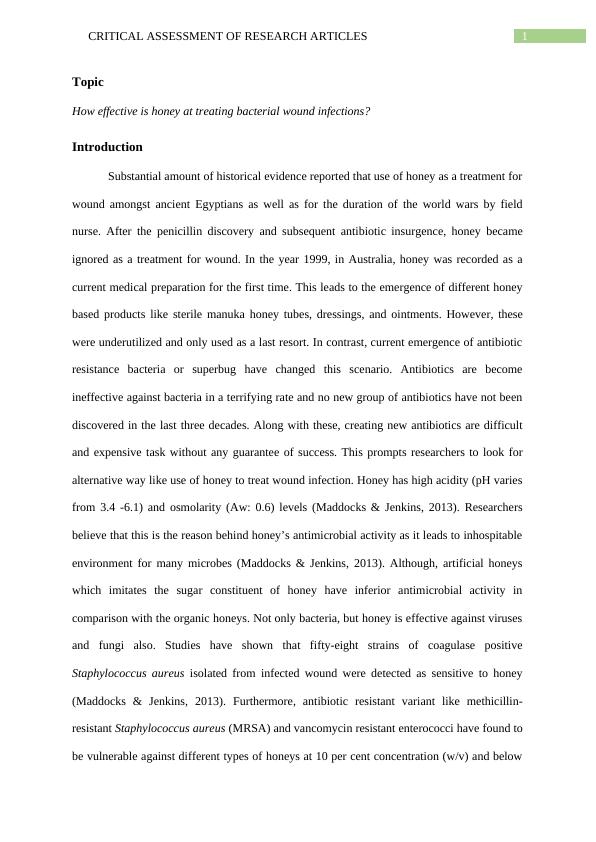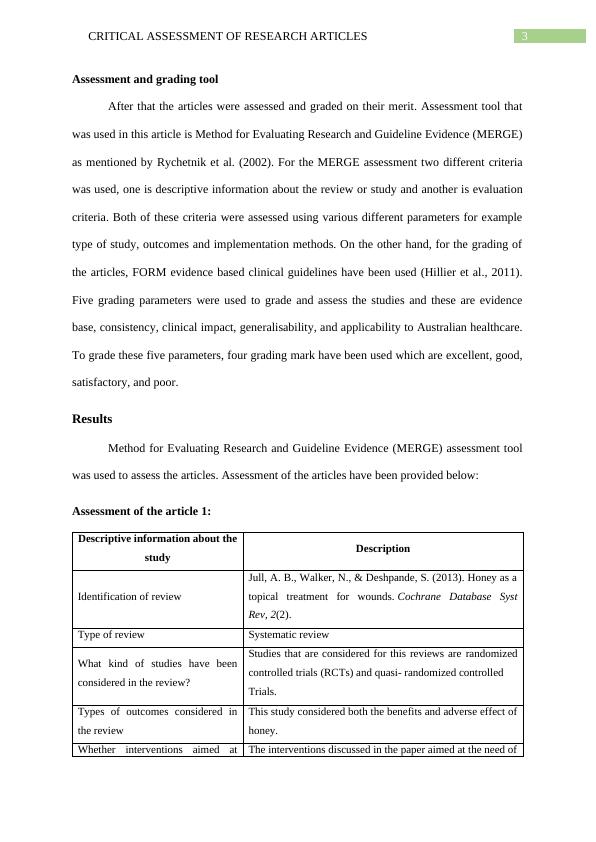Critical Assessment of Research Articles on Honey as a Treatment for Bacterial Wound Infections
Added on 2023-05-31
12 Pages3315 Words88 Views
Running head: CRITICAL ASSESSMENT OF RESEARCH ARTICLES
Critical assessment of research articles
Name of the Student
Name of the University
Author Note:
Critical assessment of research articles
Name of the Student
Name of the University
Author Note:

1CRITICAL ASSESSMENT OF RESEARCH ARTICLES
Topic
How effective is honey at treating bacterial wound infections?
Introduction
Substantial amount of historical evidence reported that use of honey as a treatment for
wound amongst ancient Egyptians as well as for the duration of the world wars by field
nurse. After the penicillin discovery and subsequent antibiotic insurgence, honey became
ignored as a treatment for wound. In the year 1999, in Australia, honey was recorded as a
current medical preparation for the first time. This leads to the emergence of different honey
based products like sterile manuka honey tubes, dressings, and ointments. However, these
were underutilized and only used as a last resort. In contrast, current emergence of antibiotic
resistance bacteria or superbug have changed this scenario. Antibiotics are become
ineffective against bacteria in a terrifying rate and no new group of antibiotics have not been
discovered in the last three decades. Along with these, creating new antibiotics are difficult
and expensive task without any guarantee of success. This prompts researchers to look for
alternative way like use of honey to treat wound infection. Honey has high acidity (pH varies
from 3.4 -6.1) and osmolarity (Aw: 0.6) levels (Maddocks & Jenkins, 2013). Researchers
believe that this is the reason behind honey’s antimicrobial activity as it leads to inhospitable
environment for many microbes (Maddocks & Jenkins, 2013). Although, artificial honeys
which imitates the sugar constituent of honey have inferior antimicrobial activity in
comparison with the organic honeys. Not only bacteria, but honey is effective against viruses
and fungi also. Studies have shown that fifty-eight strains of coagulase positive
Staphylococcus aureus isolated from infected wound were detected as sensitive to honey
(Maddocks & Jenkins, 2013). Furthermore, antibiotic resistant variant like methicillin-
resistant Staphylococcus aureus (MRSA) and vancomycin resistant enterococci have found to
be vulnerable against different types of honeys at 10 per cent concentration (w/v) and below
Topic
How effective is honey at treating bacterial wound infections?
Introduction
Substantial amount of historical evidence reported that use of honey as a treatment for
wound amongst ancient Egyptians as well as for the duration of the world wars by field
nurse. After the penicillin discovery and subsequent antibiotic insurgence, honey became
ignored as a treatment for wound. In the year 1999, in Australia, honey was recorded as a
current medical preparation for the first time. This leads to the emergence of different honey
based products like sterile manuka honey tubes, dressings, and ointments. However, these
were underutilized and only used as a last resort. In contrast, current emergence of antibiotic
resistance bacteria or superbug have changed this scenario. Antibiotics are become
ineffective against bacteria in a terrifying rate and no new group of antibiotics have not been
discovered in the last three decades. Along with these, creating new antibiotics are difficult
and expensive task without any guarantee of success. This prompts researchers to look for
alternative way like use of honey to treat wound infection. Honey has high acidity (pH varies
from 3.4 -6.1) and osmolarity (Aw: 0.6) levels (Maddocks & Jenkins, 2013). Researchers
believe that this is the reason behind honey’s antimicrobial activity as it leads to inhospitable
environment for many microbes (Maddocks & Jenkins, 2013). Although, artificial honeys
which imitates the sugar constituent of honey have inferior antimicrobial activity in
comparison with the organic honeys. Not only bacteria, but honey is effective against viruses
and fungi also. Studies have shown that fifty-eight strains of coagulase positive
Staphylococcus aureus isolated from infected wound were detected as sensitive to honey
(Maddocks & Jenkins, 2013). Furthermore, antibiotic resistant variant like methicillin-
resistant Staphylococcus aureus (MRSA) and vancomycin resistant enterococci have found to
be vulnerable against different types of honeys at 10 per cent concentration (w/v) and below

2CRITICAL ASSESSMENT OF RESEARCH ARTICLES
(Maddocks & Jenkins, 2013). Eighteen isolated strain of MRSA and seven vancomycin
resistant enterococci were amongst them. In most of the studies which investigated the
mechanism of antimicrobial actions of honey used manuka honey as its sterile preparation
has been commercially available. Revamil™ and manuka honey are only two honey variants
commercially available which are registered as medical device (Maddocks & Jenkins, 2013).
However, there is no academic evidence for any large scale clinical trial for honey as a
treatment for wound although pre- prepared honey wound dressings or tube of pure honey has
been registered as medical device. Therefore, in this critical assessment, article related to the
research question ‘How effective is honey at treating bacterial wound infections?’ will be
assessed.
Methods
Article selection
For this critical assessment, five articles have been chosen. Three of them are review
article and two of them are original research article. Focus have been given on the recent
articles related to the topic. To this extent, all five articles were selected from the timeframe
between 2013 and 2018.
Search database
The database that was used for the searching of the articles was ‘Google Scholar’
(https://scholar.google.co.in/). The custom range was used for the search by setting the
parameters between 2013 and 2018.
Search keywords
Few keywords were used to get the articles relevant to the topic discussed in this
critical assessment. Those keywords are: ‘Honey’, ‘treatment’, ‘bacterial’, and ‘infection’.
(Maddocks & Jenkins, 2013). Eighteen isolated strain of MRSA and seven vancomycin
resistant enterococci were amongst them. In most of the studies which investigated the
mechanism of antimicrobial actions of honey used manuka honey as its sterile preparation
has been commercially available. Revamil™ and manuka honey are only two honey variants
commercially available which are registered as medical device (Maddocks & Jenkins, 2013).
However, there is no academic evidence for any large scale clinical trial for honey as a
treatment for wound although pre- prepared honey wound dressings or tube of pure honey has
been registered as medical device. Therefore, in this critical assessment, article related to the
research question ‘How effective is honey at treating bacterial wound infections?’ will be
assessed.
Methods
Article selection
For this critical assessment, five articles have been chosen. Three of them are review
article and two of them are original research article. Focus have been given on the recent
articles related to the topic. To this extent, all five articles were selected from the timeframe
between 2013 and 2018.
Search database
The database that was used for the searching of the articles was ‘Google Scholar’
(https://scholar.google.co.in/). The custom range was used for the search by setting the
parameters between 2013 and 2018.
Search keywords
Few keywords were used to get the articles relevant to the topic discussed in this
critical assessment. Those keywords are: ‘Honey’, ‘treatment’, ‘bacterial’, and ‘infection’.

3CRITICAL ASSESSMENT OF RESEARCH ARTICLES
Assessment and grading tool
After that the articles were assessed and graded on their merit. Assessment tool that
was used in this article is Method for Evaluating Research and Guideline Evidence (MERGE)
as mentioned by Rychetnik et al. (2002). For the MERGE assessment two different criteria
was used, one is descriptive information about the review or study and another is evaluation
criteria. Both of these criteria were assessed using various different parameters for example
type of study, outcomes and implementation methods. On the other hand, for the grading of
the articles, FORM evidence based clinical guidelines have been used (Hillier et al., 2011).
Five grading parameters were used to grade and assess the studies and these are evidence
base, consistency, clinical impact, generalisability, and applicability to Australian healthcare.
To grade these five parameters, four grading mark have been used which are excellent, good,
satisfactory, and poor.
Results
Method for Evaluating Research and Guideline Evidence (MERGE) assessment tool
was used to assess the articles. Assessment of the articles have been provided below:
Assessment of the article 1:
Descriptive information about the
study Description
Identification of review
Jull, A. B., Walker, N., & Deshpande, S. (2013). Honey as a
topical treatment for wounds. Cochrane Database Syst
Rev, 2(2).
Type of review Systematic review
What kind of studies have been
considered in the review?
Studies that are considered for this reviews are randomized
controlled trials (RCTs) and quasi- randomized controlled
Trials.
Types of outcomes considered in
the review
This study considered both the benefits and adverse effect of
honey.
Whether interventions aimed at The interventions discussed in the paper aimed at the need of
Assessment and grading tool
After that the articles were assessed and graded on their merit. Assessment tool that
was used in this article is Method for Evaluating Research and Guideline Evidence (MERGE)
as mentioned by Rychetnik et al. (2002). For the MERGE assessment two different criteria
was used, one is descriptive information about the review or study and another is evaluation
criteria. Both of these criteria were assessed using various different parameters for example
type of study, outcomes and implementation methods. On the other hand, for the grading of
the articles, FORM evidence based clinical guidelines have been used (Hillier et al., 2011).
Five grading parameters were used to grade and assess the studies and these are evidence
base, consistency, clinical impact, generalisability, and applicability to Australian healthcare.
To grade these five parameters, four grading mark have been used which are excellent, good,
satisfactory, and poor.
Results
Method for Evaluating Research and Guideline Evidence (MERGE) assessment tool
was used to assess the articles. Assessment of the articles have been provided below:
Assessment of the article 1:
Descriptive information about the
study Description
Identification of review
Jull, A. B., Walker, N., & Deshpande, S. (2013). Honey as a
topical treatment for wounds. Cochrane Database Syst
Rev, 2(2).
Type of review Systematic review
What kind of studies have been
considered in the review?
Studies that are considered for this reviews are randomized
controlled trials (RCTs) and quasi- randomized controlled
Trials.
Types of outcomes considered in
the review
This study considered both the benefits and adverse effect of
honey.
Whether interventions aimed at The interventions discussed in the paper aimed at the need of

End of preview
Want to access all the pages? Upload your documents or become a member.
Related Documents
PUBH6005 : Epidemiology PDFlg...
|12
|3253
|212
Controlling Transmission of Healthcare Acquired Methicillin-Resistant Staphylococcus Aureus (HA-MRSA) Infectionslg...
|12
|4091
|470
Controlling Transmission of Healthcare Acquired MRSAlg...
|8
|3492
|100
Use of Manuka Honey and Leg Wrapping in Wound Healinglg...
|13
|2781
|164
Infectious Diseases and Antibiotics Assignmentlg...
|14
|3424
|108
Effectiveness of Interventions to Prevent MRSA Infection in Hospitalslg...
|17
|4823
|27
